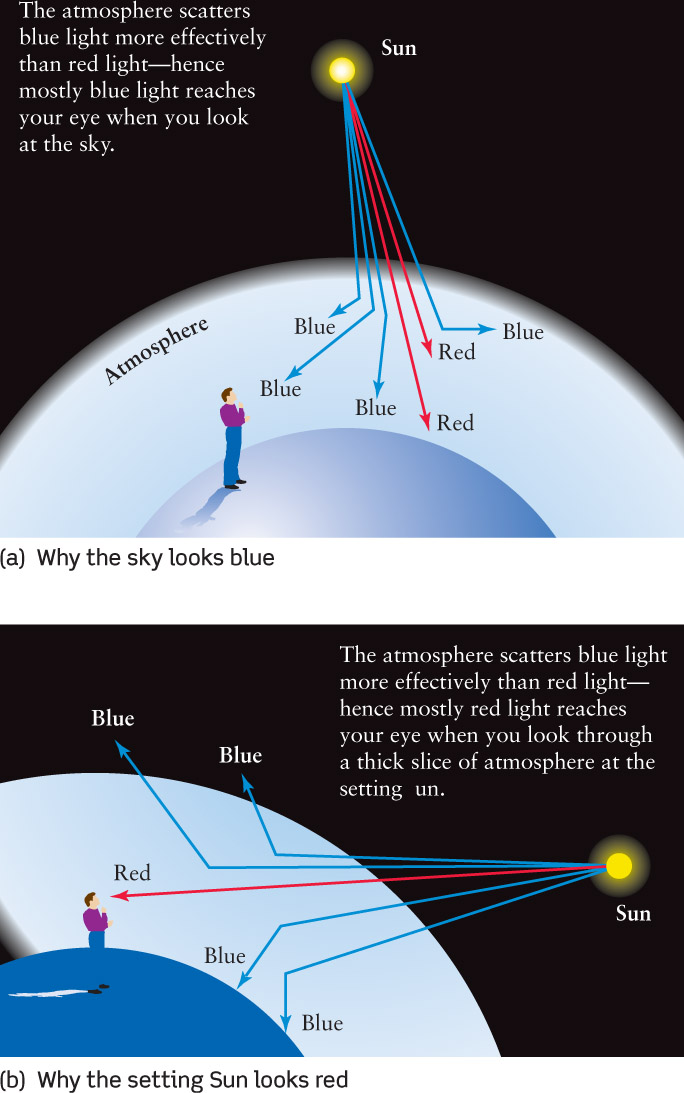BOX 5-4 ASTRONOMY DOWN TO EARTH
Why the Sky Is Blue
Light scattering is a process where photons bounce off particles, and change their direction of travel. The scattering particles can be atoms, molecules, or clumps of molecules. When you see regular objects like rocks or trees that do not produce their own intrinsic light, you see them because they scatter sunlight into your eyes.
An important fact about light scattering is that very small particles—ones that are smaller than a wavelength of visible light—are quite effective at scattering short-wavelength photons of blue light but less effective at scattering long-wavelength photons of red light. This fact explains a number of phenomena that you can see here on Earth.
The light that comes from the daytime sky is sunlight that has been scattered by the molecules that make up our atmosphere (see part a of the accompanying figure). Air molecules are less than 1 nm across, far smaller than the wavelength of visible light, so they scatter blue light more than red light—which is why the sky looks blue. In other words, the sky is blue because while incoming white sunlight contains all the colors, air molecules scatter blue light around more than red light, literally spreading blue light all throughout the atmosphere.
During the day, distant mountains often appear blue thanks to sunlight being scattered from the atmosphere between the mountains and your eyes. (The Blue Ridge Mountains, which extend from Pennsylvania to Georgia, and Australia’s Blue Mountains derive their names from this effect.)
Light scattering also explains why sunsets are red. Again, sunlight contains all the colors, but as this light passes through our atmosphere the blue light is scattered away from the straight-line path from the Sun. On the other hand, red light undergoes relatively little scattering, so light coming directly from the Sun looks a bit redder once some blue has been removed. When you look toward the setting Sun (but, never look at the Sun!), the sunlight that reaches your eye has had to pass through a relatively thick layer of atmosphere (part b of the accompanying figure). Hence, a large fraction of the blue light from the Sun has been scattered, and the Sun appears quite red. If, at sunset, the sunlight shines onto clouds, the clouds also look red after much of the blue light has been scattered away.
The same effect also applies to sunrises, but sunrises seldom look as red as sunsets do. The reason is that dust is lifted into the atmosphere during the day by the wind (which, being driven by sunlight, typically blows stronger in the daytime), and dust particles in the atmosphere help to scatter even more blue light.
Finally, some scattered light appears white. If the small particles that scatter light are sufficiently concentrated, there will be almost as much scattering of red light as of blue light, and the scattered light will then appear white. This can occur when the scattering comes from dense ice crystals or water vapor and explains the white color of snow, clouds, and fog.
Light scattering has many applications to astronomy. For example, it explains why very distant stars in our Galaxy appear surprisingly red. The reason is that there are tiny dust particles throughout the space between the stars, and this dust scatters blue light. By studying how much scattering takes place, astronomers have learned about the tenuous material that fills interstellar space.
